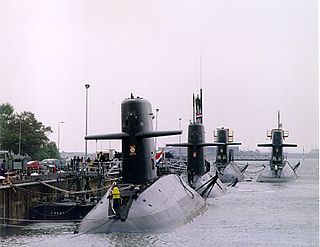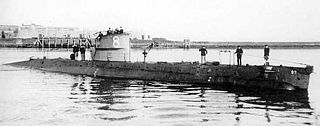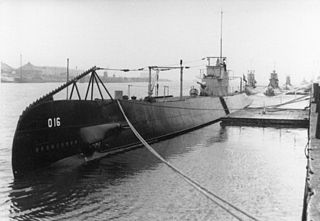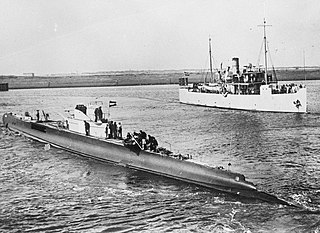
The Walrus-class submarine is the only submarine class currently in operation in the Royal Netherlands Navy. The boats have been in service since 1990 and are all named after sea mammals.

The Zwaardvis-class submarine ("Swordfish") is a class of conventional attack submarines that were built to strengthen the Royal Netherlands Navy. The Dutch government opted for the choice to not replace the two Zwaardvis-class submarines with either more Walrus-class submarines, or submarines of a new design.

Wilton-Fijenoord was a shipbuilding and repair company in Schiedam, Netherlands from 1929 to 1999. Presently, the shipyard of Wilton-Feijnoord is part of Damen Shiprepair Rotterdam.

The Holland-class destroyers were built for the Royal Netherlands Navy in the 1950s. They were the first major warships designed and built by the Dutch after World War II. In contrast to previous Dutch Navy practice the ships were named after provinces rather than admirals.

HMS H6 was a British H-class submarine of the Royal Navy built by Canadian Vickers & Co. during World War I.
The naval history of the Netherlands dates back to the 15th century. As overseas trade was a traditional cornerstone of the Dutch economy, naval defence was indispensable for the protection of commercial interests.

The Dolfijn-class submarines of the Royal Netherlands Navy are a class of four submarines; Dolfijn, Zeehond, Potvis and Tonijn. They were built in the late 1950s and the early 1960s. They were the first indigenous submarines built in the Netherlands and for the Royal Netherlands Navy after World War II. In the Netherlands they are also known as "three cylinder" submarines.

The Royal Netherlands Navy Submarine Service is a department within the Royal Netherlands Navy that is responsible for the deployment of Dutch submarines. It was established out of the Netherlands Torpedo Service on 21 December 1906, and merged with the Netherlands Mine Service on 15 July 2005.

O 19, laid down as K XIX, was an O 19-class submarine of the Royal Netherlands Navy that saw service during World War II. O 19, along with her sister ship O 20, were the first submarines in the world to be equipped with a submarine snorkel that allowed the submarine to run its diesel engines while submerged.
The O 9-class submarine consisted of three submarines, built for the Royal Netherlands Navy. Used for patrols in the Dutch home waters. The class comprised O 9, O 10, and O 11. Its diving depth was 60 metres (200 ft).

The O 12-class submarine consisted of four submarines built for the Royal Netherlands Navy. The ships, with a diving depth of 60 metres (200 ft), were used for patrols in the Dutch home waters. The class comprised O 12, O 13, O 14 and O 15. O 12 entered German service in 1943 as UD-2.

The O 21 class was a class of seven submarines, built for the Royal Netherlands Navy. The boats were still incomplete at the start of the German invasion of the Netherlands O 21, O 22, O 23 and O 24 were hastily launched and escaped to the United Kingdom. O 25, O 26 and O 27 were not able to escape and were captured by the German forces. The Kriegsmarine ordered the completion of the boats and they entered German service as UD-3, UD-4 and UD-5. The submarines' diving depth was 100 meters (330 ft).

The K XIV-class submarine was a class of five submarines, built for the Royal Netherlands Navy. Used for patrols in the Dutch colonial waters. The class comprised K XIV, K XV, K XVI, K XVII and K XVIII. The submarines diving depth was 80 m (260 ft). Three of the five ships were lost in World War II

HNLMS O 16 was a submarine of the Royal Netherlands Navy that saw service during World War II. She was the first submarine of the RNN manufactured from high-quality Steel 52, with the ability to dive at a depth of 80 metres (260 ft).

HNLMS O 12 was a O 12-class submarine of the Royal Netherlands Navy. Built at Koninklijke Maatschappij De Schelde in Vlissingen, she was launched in 1930 but was unable to take part in military action during World War II. After being scuttled by the Dutch Navy, she was raised by Nazi Germany's Kriegsmarine and taken into service as UD-2, and then scuttled again.
HNLMS O 7 was a unique patrol submarine of the Royal Netherlands Navy for use in the home waters of Europe. The ship was built by the Maatschappij Fijenoord shipyard in Rotterdam. The submarines diving depth was 40 metres. O 6 was very similar to the O 7 and they are sometimes regarded as one class.

O 1 was a Holland 7P patrol submarine of the Royal Netherlands Navy. The ship was built by the De Schelde shipyard in Flushing and was the first submarine in the Dutch navy. It had a diving depth of 25 metres.

K XVII was one of five K XIV-class submarines built for the Royal Netherlands Navy. She served during World War II.

The Roofdier class was a class of six frigates that were built in the United States as Patrol Craft Escorts (PCE) for the Netherlands. The frigates were loaned to the Royal Netherlands Navy as part of the Mutual Defense Assistance Act (MDAP) and from 1954 to 1984 served as the Roofdier-class frigates.















